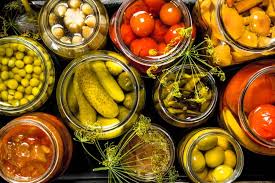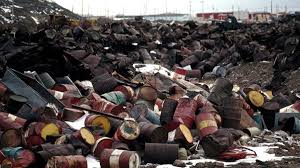Food Preservation Methods
Food preservation methods are aimed at preventing the incorporation of microbes into food, removing or destroying microbes in food and keeping microbes from multiplying.
Modern food preservation uses refrigeration, freezing, dehydration and canning. Aseptic handling and processing prevents the entry of microbes in the food.
Fruits, vegetables, grains are vigorously washed to reduce contaminants level. Meat, milk and eggs are taken as aseptically as possible to reduce contamination during handling.
Flies and insects are stopped by covering food or eliminating pests from canning area. Utensils are cleaned properly and care is taken to avoid cross contaminating cutting boards. Refrigeration retards microbial growth, however, on extended storage psychrophiles produce spoilage.
High temperature is the safest and reliable method. Moist heat is generally used. Canning introduced by Appert is called Appertisation or commercial sterilization intended to destroy the C. botulinum spores and not complete sterilization.
Read Also: Food Contamination/Pollution and Sources of Food Contamination

Enough heat is supplied for 12D treatment which means 12 decimal reduction or reduction in microbial population by 12 log cycles. Canned food is treated in special containers called retorts (which work on the principle of autoclave) at 115°C for 25-100 min. depending on the nature of the food.
Pasteurization, another widely used process for milk, beer, wines etc. kills most of the disease causing bacteria esp. Mycobacteriumtuberculosis in milk. The LTH, low temperature holding process or vat pasteurization is heating each and every particle of milk at 145°F (62.8°C) for 30 min.
The HTST or high temperature short time process or flash pasteurization uses 161°F (71.7°C) for 15 sec and the UHT, ultra high temperature is treated at 141°C for 2 sec. Irradiation both ionizing and nonionizing are used to target opportunistic pathogens like E.coli 0157H7.
Herbs, spices and seasonings are irradiated to keep the microbial count low. It is also used to kill the insects from wheat products, prevent sprouting of potatoes during storage and delay fruit ripening. People need to be educated as regards the safety of irradiated food.
Read Also : Importance of Water Purification to Public Health and Safety
A more familiar word like cold pasteurization should be substituted to facilitate that. The irradiated foods carry the international irradiation logo.
For deeper penetration gamma rays dose of 4.5 – 5.6 megarads produced by Cobalt 60 are used. Alternatively high energy electron accelerator generates electrons that are faster than γ rays but have low penetration.
Dehydration is an age-long process. Sun drying is used for grains, meat, fish and fruits. Microwaves are high frequency electromagnetic microwaves that create vibrations among the molecules of food creating heat that kills the microorganisms.
High osmotic process is used to withdraw water from microbial metabolism. The effect is similar to dehydration. Chemicals that are generally regarded as safe (GRAS), include organic acids, sulfite, ethylene oxide as sterilents.
Sodium nitrite and ethyl formate are solid preservatives. The Food and Drug Administration of US gives the GRAS status to harmless chemicals.
These chemicals damage the plasma membrane, denature various cell proteins, and interfere with the functioning of nucleic acids and kill microorganisms. The concentrations used are 0.1 –0.3% or 15–700 ppm.
Antibiotics like nisin a polypeptide agent are used in food preservation. Nisin is produced by Lactococcuslactis and affects gram positive bacteria.
Read Also: Farm Automation: Revolutionizing Agriculture for a Sustainable Future



